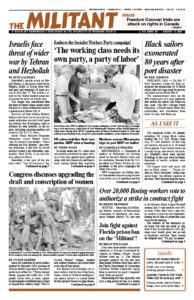The crisis of child care for the working class has worsened since the government’s $24 billion pandemic relief program ended last September. Pressures are increasing, especially on women, to quit work in order to look after children, while the rise in prices on other essentials is leading many young workers to put off starting families.
Between 2019 and 2023 child care costs jumped more than 30%.
“I knew day care was expensive, but I guess I didn’t put into perspective how much it would be,” Carmen Luong, 29, told the Philadelphia Inquirer. “It’s a whole mortgage payment or rent basically.” Infant care in the city costs on average more than 22% of median family income. When Luong’s retired father heard about the cost, he volunteered to look after her 4-month-old son in South Philadelphia.
Not everyone can turn to family members.
Jane Roberts told the Associated Press that she and husband Mike, both teachers in Pocatello, Idaho, realized the high cost of child care meant it was out of the question for their son. As a result Jane decided she’ll quit her job this fall.
Tyler and Amy Salovin pay $26,000 a year for child care for their two daughters in Springfield, Pennsylvania. “It’s not the only reason we’re not having any more kids,” said Amy, “but it’s a factor.”
In New York City a family spends on average over 25% of its income for the care of one child.
Some 80% of families in that city cannot afford child care for children under 5, and nearly four out of five families cannot pay for out-of-school care for children ages 6 to 12, the Citizens’ Committee for Children reported last year. In the Bronx and Brooklyn, the group says, “the cost of child care or out-of-school care would consume up to more than half (63%) of their annual income.”
The rising costs of child care have nothing to with what child care workers get paid. In New York a quarter of them live in poverty. Median pay nationally for child care workers is $15 an hour. Staffing shortages are rampant throughout the country, at both licensed and nonlicensed facilities.
Some 43% of parents have waited more than four months for an opening at a day care center. “There was such a long list for all of them,” Rebecca Lane told the Inquirer, “we would have had to have signed up on a wait list before I knew even that I was pregnant.”
High prices for rent, child care and other essentials lead many workers to try to hold down two or more jobs, leaving no time to relax, nor for union or social activity, nor time with families.
Adriane Burnett, a single mom in Birmingham, Alabama, earns $2,800 a month as a customer service representative, spending more than a third of that on care for her 3 year old. In October her child aged out of a program that provided her with some child care benefits. Burnett had to take a second job as a food delivery driver, borrowing her father’s car for the job after she lost her own when she got behind on payments. She gets her 14 year old to babysit the toddler while she’s making deliveries.
In rural areas the child care crisis is worse. Nearly two-thirds of families live where there are at least three young children for every licensed child care opening — or no licensed providers at all.
The labor movement needs to lead a fight for universal child care and medical care as an integral part of the fight for jobs, wages and cost-of-living protections. That’s the road to advancing the fight for women’s emancipation.

